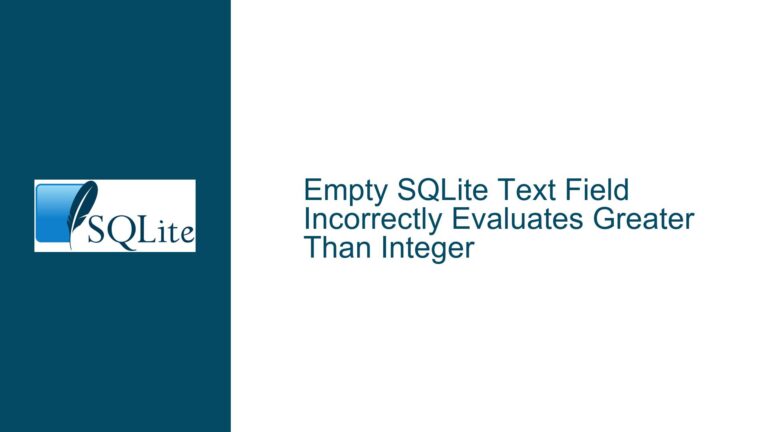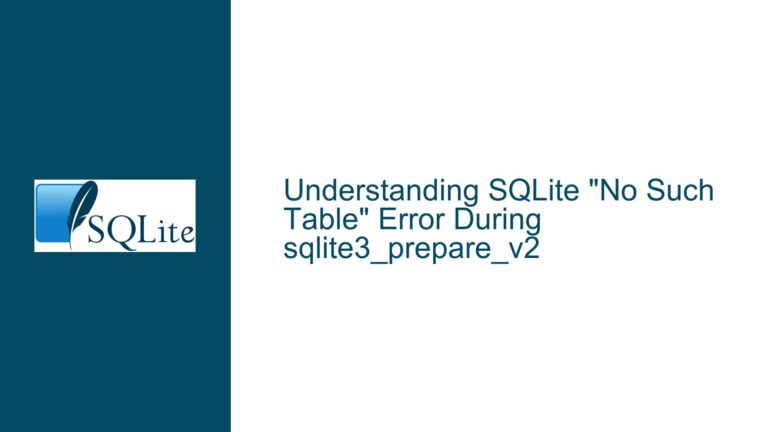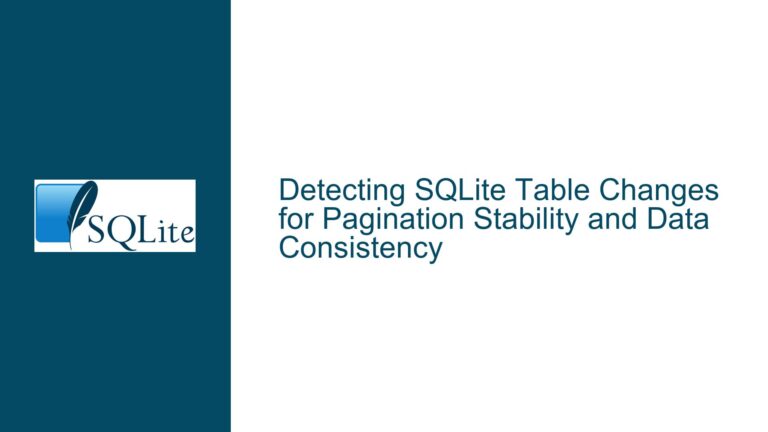RETURNING Clause in SQLite UPDATE Queries: Pre-Update Value Retrieval Limitations
Understanding the Absence of Pre-Update Value Access via RETURNING in SQLite
Core Mechanics of SQLite’s RETURNING Clause and Update Operations
The RETURNING clause in SQLite allows developers to retrieve values from rows modified by INSERT, UPDATE, or DELETE statements. When used with an UPDATE query, RETURNING returns the post-update values of the specified columns. This behavior is intentional and aligns with the SQL standard’s definition of RETURNING clauses. SQLite does not natively support returning pre-update values through this mechanism because the clause is designed to reflect the final state of the data after the operation completes.
The absence of pre-update value retrieval stems from SQLite’s architectural decisions. When an UPDATE statement executes, the database engine applies changes to the rows in-place, and the previous values are not retained in a way that the RETURNING clause can access them. The engine prioritizes efficiency and minimal locking, which means historical versions of rows are not preserved during standard operations unless explicitly managed through features like the UNDO log (used in transactions) or versioning systems (e.g., Write-Ahead Logging). However, these mechanisms are internal and not exposed to the RETURNING clause.
This limitation becomes apparent in scenarios where applications require an audit trail, conflict resolution, or conditional rollbacks based on pre-update states. For example, a banking application might need to log an account balance before deducting funds. Without access to pre-update values via RETURNING, developers must implement alternative strategies to capture this data.
Why SQLite’s Design Excludes Pre-Update Values in RETURNING
SQLite’s lightweight design philosophy emphasizes simplicity and portability. Features that introduce significant overhead or complexity are often excluded unless they serve a broad use case. Retaining pre-update values for arbitrary RETURNING clauses would require the engine to:
- Create temporary copies of rows before modification.
- Manage additional memory or storage for these copies.
- Introduce synchronization mechanisms to handle concurrent access to historical and current data.
These requirements conflict with SQLite’s goals of being a compact, embeddable database. Furthermore, the SQL standard does not mandate support for pre-update value retrieval in RETURNING clauses, which reduces the urgency for SQLite to deviate from its design principles to implement this feature.
Another factor is the transactional model. SQLite uses atomic commit and rollback mechanisms to ensure data integrity. While transactions can isolate changes until they are committed, they do not inherently expose intermediate states (like pre-update values) to DML statements. The RETURNING clause operates within the scope of the statement’s execution, not the transaction’s lifecycle, further limiting its ability to access historical data.
Workarounds and Robust Alternatives for Pre-Update Value Capture
To retrieve pre-update values in SQLite, developers must bypass reliance on the RETURNING clause and adopt alternative methods. These approaches vary in complexity, performance impact, and suitability for different use cases.
1. Explicit Pre-Update SELECT Queries
The most straightforward method involves executing a SELECT statement to fetch the current values of the target rows before performing the UPDATE. This requires a two-step process:
- Step 1: Query the database to retrieve the pre-update values using a SELECT statement with appropriate filters.
- Step 2: Execute the UPDATE statement and use RETURNING to obtain post-update values if needed.
Example:
-- Retrieve pre-update values
SELECT id, balance FROM accounts WHERE user_id = 101;
-- Update and return new values
UPDATE accounts
SET balance = balance - 50
WHERE user_id = 101
RETURNING id, balance;
Pros: Simple to implement, no schema changes required.
Cons: Introduces additional round-trips between the application and database. In high-concurrency environments, this method risks race conditions if other transactions modify the same rows between the SELECT and UPDATE.
2. Triggers for Historical Data Logging
SQLite triggers can automate the capture of pre-update values. By defining a BEFORE UPDATE trigger, developers can record the old values into a separate audit table before the UPDATE occurs.
Example:
-- Create audit table
CREATE TABLE account_audit (
id INTEGER PRIMARY KEY,
old_balance INTEGER,
new_balance INTEGER,
updated_at DATETIME
);
-- Create trigger
CREATE TRIGGER log_balance_change
BEFORE UPDATE ON accounts
BEGIN
INSERT INTO account_audit (old_balance, new_balance, updated_at)
VALUES (OLD.balance, NEW.balance, datetime('now'));
END;
-- Perform update
UPDATE accounts
SET balance = balance - 50
WHERE user_id = 101
RETURNING id, balance;
Pros: Atomic capture of pre-update values without additional application logic. Works seamlessly with concurrent transactions.
Cons: Requires schema modifications (audit tables) and trigger maintenance. Overhead increases with frequent updates.
3. Leveraging Common Table Expressions (CTEs) for Atomic Operations
SQLite 3.8.3+ supports CTEs, enabling complex queries with multiple operations in a single statement. By combining SELECT and UPDATE within a CTE, developers can retrieve pre-update values and return both old and new values.
Example:
WITH old_data AS (
SELECT id, balance AS old_balance
FROM accounts
WHERE user_id = 101
)
UPDATE accounts
SET balance = balance - 50
WHERE user_id = 101
RETURNING
(SELECT old_balance FROM old_data) AS old_balance,
balance AS new_balance;
Pros: Single database operation reduces race condition risks. Combines pre-update retrieval and post-update logic.
Cons: Requires careful handling of row matching in CTEs. May not scale well for bulk updates.
4. Application-Level Versioning
Maintaining version numbers or timestamps in the table allows applications to detect changes and reconstruct historical states.
Example:
ALTER TABLE accounts ADD COLUMN version INTEGER DEFAULT 0;
-- Retrieve current version and value
SELECT id, balance, version FROM accounts WHERE user_id = 101;
-- Update with version check
UPDATE accounts
SET balance = balance - 50, version = version + 1
WHERE user_id = 101 AND version = :current_version
RETURNING id, balance, version;
Pros: Integrates change tracking into the data model. Prevents accidental overwrites with optimistic concurrency control.
Cons: Requires schema changes and application logic to handle version mismatches.
5. Shadow Tables for Change Tracking
Create a duplicate table that mirrors the structure of the target table. Use triggers to populate the shadow table with pre-update values whenever an UPDATE occurs.
Example:
-- Shadow table
CREATE TABLE accounts_shadow (
id INTEGER,
old_balance INTEGER,
new_balance INTEGER,
updated_at DATETIME
);
-- Trigger to populate shadow table
CREATE TRIGGER capture_account_changes
AFTER UPDATE ON accounts
BEGIN
INSERT INTO accounts_shadow (id, old_balance, new_balance, updated_at)
VALUES (OLD.id, OLD.balance, NEW.balance, datetime('now'));
END;
-- Perform update
UPDATE accounts
SET balance = balance - 50
WHERE user_id = 101
RETURNING id, balance;
Pros: Decouples audit data from the main table. Simplifies historical queries.
Cons: Doubles storage requirements. Trigger overhead affects write performance.
6. Hybrid Approach: Transactional Isolation with Snapshot Queries
SQLite’s transactional isolation can be leveraged to create a snapshot of data before an update. By wrapping operations in a transaction, applications can query pre-update values and perform updates atomically.
Example:
BEGIN TRANSACTION;
-- Pre-update snapshot
SELECT id, balance FROM accounts WHERE user_id = 101;
-- Update and return new values
UPDATE accounts
SET balance = balance - 50
WHERE user_id = 101
RETURNING id, balance;
COMMIT;
Pros: Ensures consistency with transactional guarantees.
Cons: Requires explicit transaction management. Locks may affect concurrency.
Choosing the Right Strategy
The optimal solution depends on factors such as:
- Concurrency Requirements: Triggers and CTEs minimize race conditions but add complexity.
- Performance Constraints: Pre-update SELECTs are simple but inefficient for bulk operations.
- Audit Needs: Shadow tables and triggers provide robust historical tracking at the cost of storage.
- Application Architecture: Versioning and CTEs require application-level adjustments but avoid schema changes.
By understanding SQLite’s limitations and these workarounds, developers can effectively bridge the gap between the RETURNING clause’s capabilities and their application’s requirements for pre-update value retrieval.






